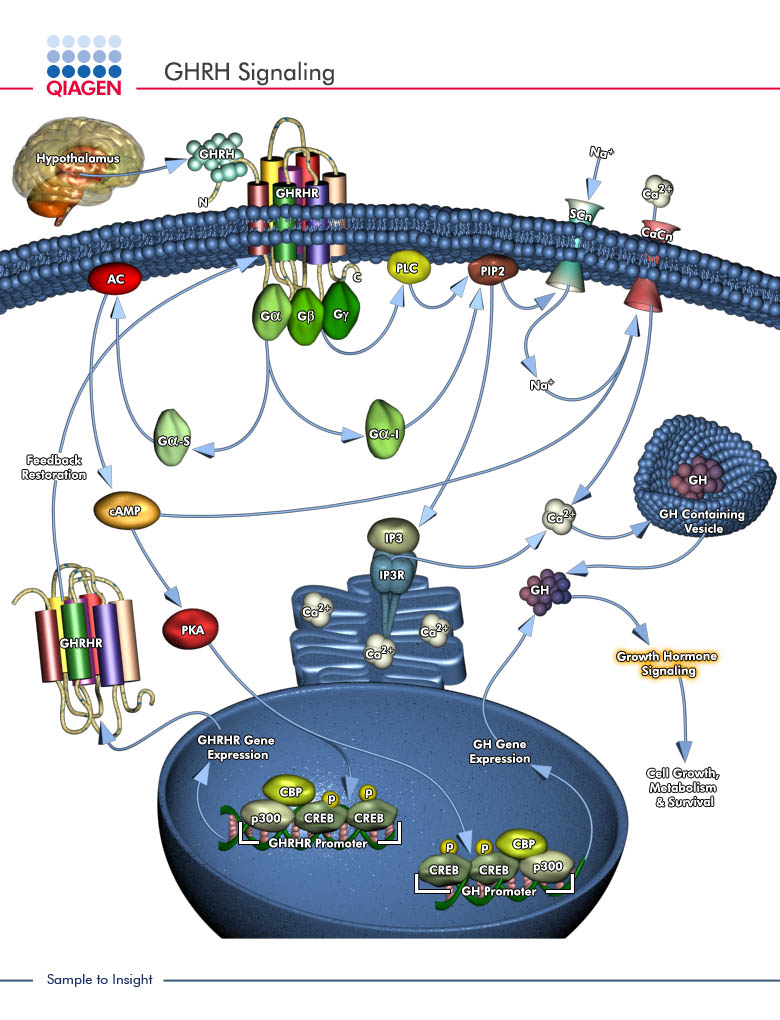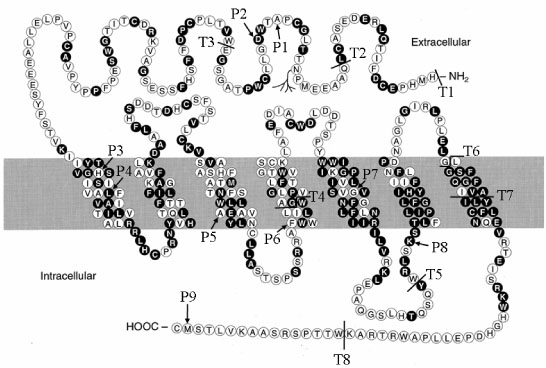Sandbox WWC5
From Proteopedia
Contents |
Growth Hormone Releasing Hormone
|
Introduction
Growth hormone releasing hormone (GHRH) is a secretory neurohormone that causes growth hormone to be released from the pituitary gland. It is naturally produced in the arcuate nucleus of the hypothalamus. The hormone is produced as a 44 amino acid peptide hormone, and first appears in the hypothalamus between 18 and 29 weeks of gestation, corresponding to the initial production of growth hormone by the fetus [1]. Growth hormone is required for normal fetal and post fetal development, including bone growth and the regulation of protein production and the metabolism of lipids and carbohydrates [2].
The color key below indicates the N to C directionality of the GHRH protein model to the right.
| Amino Terminus | Carboxy Terminus |
Nomenclature
Endogenous:
somatoliberin
somatocrinin
growth hormone–releasing hormone (GHRH or GH-RH; HGNC symbol is GHRH)
growth hormone–releasing factor (GHRF or GRF)
somatotropin-releasing hormone (SRH)
somatotropin-releasing factor (SRF)
Pharmaceutical:
somatorelin (INN)[3]
Structural Features
Primary Structure
The 44-long amino acid sequence for GHRH is:
HO - Tyr - Ala - Asp - Ala - Ile - Phe - Thr - Asn - Ser - Tyr - Arg - Lys - Val - Leu - Gly - Gln - Leu - Ser - Ala - Arg - Lys - Leu - Leu - Gln - Asp - Ile - Met - Ser - Arg - Gln - Gln - Gly - Glu - Ser - Asn - Gln - Glu - Arg - Gly - Ala - Arg - Ala - Arg - Leu - NH2[3]
Synthesis
GHRH is synthesized by neurons in the arcuate nucleus of the hypothalamus. Axons of the GHRH neurons project to the median eminence, and terminate on the capillaries of the hypothalamic-pituitary portal vessel. GHRH is then carried to the somatotroph cells of the anterior pituitary, where it binds to cause growth hormone release [4].
GHRH Receptor
The GHRH receptor gene is expressed in the pituitary as a G-coupled receptor that binds GHRH, resulting in the release of growth hormone [5]. Characteristic of G-coupled type receptors, the GHRH receptor has 7 membrane spanning portions. The gene coding for GHRHR is found on chromosome 7 [6]. The figure below and to the left is a model of the extracellular domain of the GHRH receptor. The figure below and to the right shows the extracellular and membrane spanning sections of the GHRH receptor, with possible single nucleotide points of mutation indicated by the letters T and P.
|
Function and Pathway
Increased Transcription of GH and the GHRH Receptor
The binding of GHRH to its receptor activates the alpha subunit of the associated G-protein complex, stimulating membrane bound adenylyl cyclase and causing an increase in intracellular cAMP concentrations [8]. cAMP binds and activates protein kinase A (PKA), which releases catalytic subunits which migrate to the nucleus and phosphorylate CREB (cAMP response element binding protein). The phosphorylated CREB, with its cofactors, enhance transcription of various genes by binding to specific DNA promoter regions. GHRH, acting indirectly by activating CREBs, increases the transcription of genes for both growth hormone and the GHRH receptor [9].
Release of GH Secretory Vesicles
The binding of GHRH to its receptor also mediates cAMP-dependent and cAMP-independent pathways that cause an influx of extracellular Ca2+, leading to the rapid release of growth hormone secretory vesicles and a corresponding increase in circulating GH [10]. The activation of the alpha subunit of the G-protein complex results in the activation of PIP2, which in turn leads to the opening of Na+ channels in the somatotrope, causing it to depolarize. The change in intracellular voltage opens a voltage gated Ca2+ channel, allowing an influx of Ca2+ which directly causes the release of premade GH in secretory granules [11].
GHRH also directly stimulates PLC (phosphlipase C), producing both PIP2 and IP3, leading to the release of intracellular Ca2+ from the endoplasmic reticulum, ultimately causing the release of GH secretory granules [12].
The multiple signaling systems activated by GHRH, which mediate the proliferative effects of the hormone, are shown in the figure below [6].
 [6]
[6]
Regulation via Somatostatin
Somatostatin, also known as growth hormone inhibiting hormone (GHIH), opposes the actions of GHRH at the hypothalamus. Somatostatin is a released at the hypothalamus into the pituitary portal, as well as at the pancreas and other places in the digestive system. At the pituitary, somatostatin inhibits the secretion of growth hormone. Somatostatin and GHRH are secreted in alternation, leading to the markedly pulsatile secretion of growth hormone [13].
Medical Implications
Excessive GHRH
During early development of the pituitary, high levels of GHRH are essential for expanding the somatotrope. However, excessive GHRH action/secretion during natal development and through adolescence results in unregulated somatotrope proliferation, leading to hyperplasia and neoplastic transformation (pituitary growth or tumors) [14]. Additionally, high GHRH influences high levels of GH, which causes the liver to release high amounts of IGF-1 - a growth factor influencing cell division in most of the tissues in the body. High circulating IGF-1 can bind to receptors on tumors, increasing growth rate [15].
Insufficient GHRH
Decreased production/action of GHRH results in somatotrope hypoplasia, and decreased expression of GHRH receptors. In addition, low GHRH levels result in growth hormone deficiency (GHD), which is responsible for short stature and other developmental disorders [16].
Cognition Enhancement in the Elderly
Administration of a GHRH analog (Tesmorelin) was shown to improve subjective and objective measures of cognitive function in mildly impaired eldely individuals in a placebo-controlled trial. The administration of Tesmorelin was well tolerated, with no adverse side effects, and the results also were suggestive that Tesmorelin was protective/preservative of verbal memory [17].
GHRH Antagonists in Potentiating Effects of Chemotherapy
In various types of cancer, pituitary type GHRH receptors and their splice variants are produced in the tissues of the malignancy. Thus, GHRH released from the hypothalamus can accelerate the growth/progression of these cancer types. The administration of a GHRH antagonist drugs has been shown to increase the efficacy of chemotherapy treatments [18].
Treatment of HIV Induced Lipodystrophy
Tesmorelin, a GHRH analog, has been approved by the FDA for the treatment of lipydystrophy, or the excessive distribution of abdominal fat associated with anti-retroviral treatment. Patients treated with Tesmorelin experience greater loss of abdominal fat as compared to those treated with placebo [19].
References
- ↑ Chawla RK, Parks JS, Rudman D. Structural variants of human growth hormone: biochemical, genetic, and clinical aspects. Annu Rev Med. 1983;34:519-47. PMID:6344776 doi:http://dx.doi.org/10.1146/annurev.me.34.020183.002511
- ↑ Tang SS, Zhang JH, Du MH, Wu J, Liu JJ. Construction and activity of a novel GHRH analog, Pro-Pro-hGHRH(1-44)-Gly-Gly-Cys. Acta Pharmacol Sin. 2004 Nov;25(11):1464-70. PMID:15525469
- ↑ 3.0 3.1 https://en.wikipedia.org/wiki/Growth_hormone%E2%80%93releasing_hormone
- ↑ Lin-Su K, Wajnrajch MP. Growth Hormone Releasing Hormone (GHRH) and the GHRH Receptor. Rev Endocr Metab Disord. 2002 Dec;3(4):313-23. PMID:12424433
- ↑ Gaylinn BD. Molecular and cell biology of the growth hormone-releasing hormone receptor. Growth Horm IGF Res. 1999 Apr;9 Suppl A:37-44. PMID:10429879
- ↑ 6.0 6.1 6.2 https://www.qiagen.com/us/shop/genes-and-pathways/pathway-details?pwid=199
- ↑ http://synapse.koreamed.org/DOIx.php?id=10.3803/jkes.2006.21.3.173&vmode=PUBREADER#!po=25.0000
- ↑ Cunha SR, Mayo KE. Ghrelin and growth hormone (GH) secretagogues potentiate GH-releasing hormone (GHRH)-induced cyclic adenosine 3',5'-monophosphate production in cells expressing transfected GHRH and GH secretagogue receptors. Endocrinology. 2002 Dec;143(12):4570-82. PMID:12446584 doi:http://dx.doi.org/10.1210/en.2002-220670
- ↑ Lin-Su K, Wajnrajch MP. Growth Hormone Releasing Hormone (GHRH) and the GHRH Receptor. Rev Endocr Metab Disord. 2002 Dec;3(4):313-23. PMID:12424433
- ↑ Yue G, Malik B, Yue G, Eaton DC. Phosphatidylinositol 4,5-bisphosphate (PIP2) stimulates epithelial sodium channel activity in A6 cells. J Biol Chem. 2002 Apr 5;277(14):11965-9. Epub 2002 Jan 25. PMID:11812779 doi:http://dx.doi.org/10.1074/jbc.M108951200
- ↑ Frohman LA, Kineman RD. Growth hormone-releasing hormone and pituitary development, hyperplasia and tumorigenesis. Trends Endocrinol Metab. 2002 Sep;13(7):299-303. PMID:12163232
- ↑ Garcia-Fernandez MO, Schally AV, Varga JL, Groot K, Busto R. The expression of growth hormone-releasing hormone (GHRH) and its receptor splice variants in human breast cancer lines; the evaluation of signaling mechanisms in the stimulation of cell proliferation. Breast Cancer Res Treat. 2003 Jan;77(1):15-26. PMID:12602901
- ↑ Costoff A. "Sect. 5, Ch. 4: Structure, Synthesis, and Secretion of Somatostatin". Endocrinology: The Endocrine Pancreas. Medical College of Georgia. p. 16. Retrieved 2016-05-11
- ↑ Frohman LA, Kineman RD. Growth hormone-releasing hormone and pituitary development, hyperplasia and tumorigenesis. Trends Endocrinol Metab. 2002 Sep;13(7):299-303. PMID:12163232
- ↑ Kiaris H, Chatzistamou I, Schally AV, Halmos G, Varga JL, Koutselini H, Kalofoutis A. Ligand-dependent and -independent effects of splice variant 1 of growth hormone-releasing hormone receptor. Proc Natl Acad Sci U S A. 2003 Aug 5;100(16):9512-7. Epub 2003 Jul 16. PMID:12867592 doi:http://dx.doi.org/10.1073/pnas.1533185100
- ↑ Kiaris H, Chatzistamou I, Schally AV, Halmos G, Varga JL, Koutselini H, Kalofoutis A. Ligand-dependent and -independent effects of splice variant 1 of growth hormone-releasing hormone receptor. Proc Natl Acad Sci U S A. 2003 Aug 5;100(16):9512-7. Epub 2003 Jul 16. PMID:12867592 doi:http://dx.doi.org/10.1073/pnas.1533185100
- ↑ http://www.medpagetoday.com/MeetingCoverage/ICAD/27675
- ↑ Schally AV, Perez R, Block NL, Rick FG. Potentiating effects of GHRH analogs on the response to chemotherapy. Cell Cycle. 2015;14(5):699-704. doi: 10.1080/15384101.2015.1010893. PMID:25648497 doi:http://dx.doi.org/10.1080/15384101.2015.1010893
- ↑ http://www.medpagetoday.com/InfectiousDisease/HIVAIDS/23291

